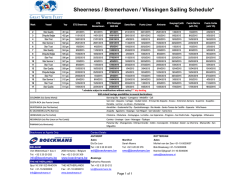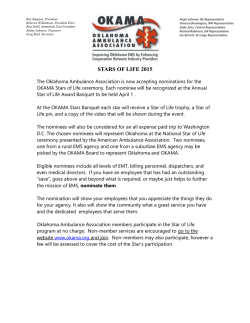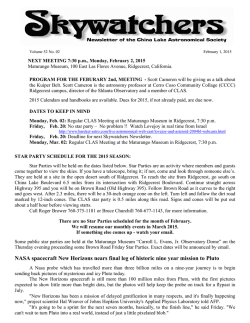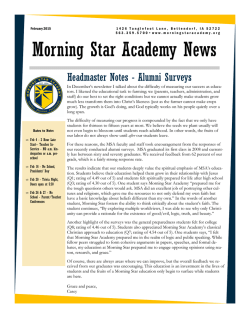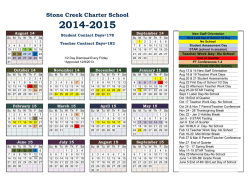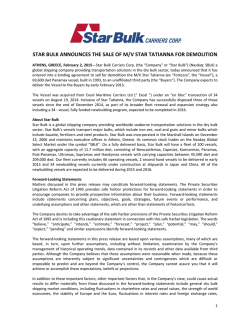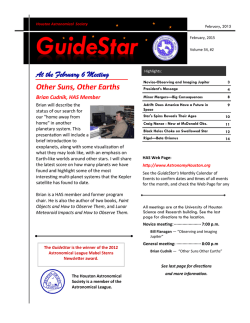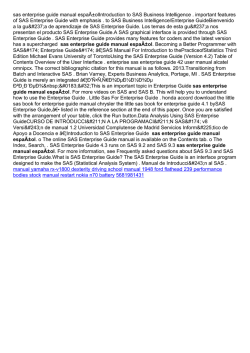
General Meeting: Olson Hall Room 120, at Pacific Stockton
Volume No. 65 February 2015 Issue No. 2 Stockton Astronomical Society: founded November 1950 by Clarence P. Custer, M.D., 1906-1998 (Meetings of the Stockton Astronomical Society are held on the second Thursday of each month, and are open to the public.) IN THIS ISSUE: Stockton Astronomical Society Editor’s Corner NuSTAR ..................................................... 2 Stars R Us February Star Parties ............................... 3 Directions to Star Party Sites .................. 3 Amateur Telescope Makers………......….3 Teaching Opportunities for Partners in Science (TOPS) in need of volunteers....3 Hubble: Pillars of Creation are also Pillars of Destruction……………………...3 Telescope Nut Musée des Arts et Métiers ....................... 4 Letter from Eric Holland………………......5 Night Skies Star Stencils………………….5 NASA Space Place Minor mergers have massive consequences for black holes ................ 6 Public Astronomy Star Party Reports .................................... 7 Science@NASA Kepler Discovers 1000th Exoplanet ....... 8 January Sky Calendar .............................. 9 Stockton Evening Sky............................ 10 Membership Application........................ 11 What’s Up? .............................................. 11 NASA’s Image of the Day Gallery..........11 General Meeting: Olson Hall Room 120, at Pacific Thursday, February 12 – 7:30 p.m. Stockton Astronomical Society Presents Omar Anzaldua, Eric Holland, Doug Christensen and Jeff Baldwin How to Find Stuff With Your Telescope This session will cover the use of setting circles, GoTo programs, star charts, and finding planets during the daytime. This is an installment of in-club personnel showing club members basic astronomy and telescope procedures. Future shows will include collimation of optics, cleaning of optics, astrophotography, optical fabrication and other practical jobs and activities. If you want to practice with us you can bring your telescope along. If it’s clear we might even go outside afterwards and gawk at a few fine objects. All four of our speakers [and maybe more may join in] are members of the Stockton Astronomical Society, are experienced observers and imagers, and are all dedicated to promoting astronomy to the public, to schools, and to club members. Next month will be a program on the Messier Marathon, and this discussion will help tremendously in the ability to find and document Messier objects. …Jeff Baldwin, Program Director Visit the SAS Web Site at: www.stocktonastro.org Valley Skies STOCKTON ASTRONOMICAL SOCIETY February 2015 page 2 Editor’s CornEr… P.O. Box 243, Stockton, CA 95201 OFFICERS FOR 2015: President Eric Holland……..……..351-0206, [email protected] Vice President & Program Director Jeff Baldwin……………...594-1894, [email protected] Secretary Bret Ford………………..471-2131, [email protected] Treasurer Gerald Hyatt………565-1424, [email protected] Newsletter Editor Rebecca Lewis……………………………..(925) 549-1352, [email protected] Members-at-Large Doug Christensen.. …462-0798, [email protected] Dave Jacobi…...….823-0328, [email protected] APPOINTED OFFICERS: Public Outreach Coordinator School Star parties: Doug Christensen.. …462-0798, [email protected] Sky Tours & other public viewing: Doug Christensen.. …462-0798, [email protected] Star Party Coordinators Hi-Altitude: Miguel Ortiz…….…823-0723, [email protected] Highway 4: Jim Schuknecht……………224-5267, [email protected] Shawn Kerns……….……986-4185 [email protected] Star Party Bulletin Board https://groups.yahoo.com/neo/groups/stocktonastro/info Equipment Manager Jeff Baldwin……..……..594-1894, [email protected] ATM Workshops Jeff Baldwin……..……..594-1894, [email protected] Observing Program Chairman Jeff Baldwin……..……..594-1894, [email protected] Striking Sparks Program Coordinator Gerald Hyatt………565-1424, [email protected] SAS Rep to A.A.N.C. Dennis LeClert……………..477-4756, [email protected] Web Site Administrator Ray Lukaszewski……………….…………..916-683-2186 [email protected] SAS Web Site: www.stocktonastro.org (All numbers are area code 209 except as noted) Valley Skies is published monthly. Except where noted, it is not copyrighted and may be freely copied and distributed, with appropriate credits. Articles of interest, letters, news items or announcements are welcome. Please send them to the Society address above. Non-commercial advertising of astronomy-related products or services will be printed free of charge for members, for up to three months if necessary. Submission deadline is the 15th of each month. NuSTAR Besides the telescopes such as those amateur astronomers possess or have access to, other scopes include ones like the Nuclear Spectroscopic Telescope Array, which detect the X-rays given off by certain cosmic objects in order to view them. Following the theme of telescopes themselves at this month's meeting, I wanted to concentrate on this particular scope. It is the first orbiting telescope to use true focusing optics to focus X-rays, an arrangement that is a modification of the Wolter-1 design. Previous X-ray telescopes in orbit have not done this, and instead used coded apertures to detect the required electromagnetic range. The NuSTAR mainly targets black holes, relativistic jets, neutron stars, and supernovae explosions. The purpose of studying black holes is to understand how they are both the remnants of dead stars as well as the foundations for galaxies, as made evident by their existence at galactic centers. Some super massive black holes exhibit the behavior of shooting off jets of material, called relativistic jets, close to the speed of light. The physics behind the phenomenon of these jets is not understood, making it another of the primary missions of NuSTAR. In addition, NuSTAR also hunts for other remnants of stars in order to understand the evolution of them. Neutron stars and supernovae exist as part of the fossil record of the universe. Supernovae explosions can inform us on the creation of elements during a star’s death, and neutron stars illustrate how matter is affected by gravity and magnetic fields at their extremes. For further information on the Nuclear Spectroscopic Telescope Array, visit http://www.nustar.caltech.edu/page/about …Rebecca Lewis SAS Meeting: Thursday February 12, 7:30 p.m. Olson Room 120 at UOP (Refreshments generously provided by Jeff and Glenda Baldwin) Valley Skies Page 3 February 2015 Stars R Us... SAS Star Party News February: Saturday, Feb 14 Sunset: Moonset Saturday, Feb 21 Sunset: Moonset Hwy 4 Star Party 5:43 PM PST 1:23 PM PST Hi-Alt Star Party 5:50 PM PST 9:28 PM PST Directions to SAS Star Party Sites Highway 4/Shirley Road: Drive 30 miles east on Hwy 4 from Hwy 99. At the sign for Shirley Road/Telegraph Road, turn right off Hwy 4, then left at the stop sign. You will again be heading east, parallel to Hwy 4. Drive to the setup area at the end of the road. 4000' Heliport on Highway 88: Drive 21.8 miles east from Jackson on Hwy 88 till you pass the “Elevation 4,000 ft.” sign, (0.4 miles past Amador Station). Turn left at the “Emergency Heliport” sign and double back parallel to the road about 400 feet to the helipad. Set up on the north side. (Please park on N side of road only at both the Hwy 4 and 4000 ft. site. Peddler Hill: (Access unlikely) Amateur Telescope Makers ATM We had an ATM session at the shop Saturday, January 10, 2015. Omar, Larry, Eric and Jeff kept pretty busy the whole time. Marshal showed up to hand his telescope over to Larry, who showed up later. Jeff worked on a TDE on a mirror. Eric ground from 220 grit through 500 grit on his mirror, and is now ready for aluminum oxide fine-grinding. Omar tore his wedge apart, sand blasted it, and painted it a nice, shiny black. We also over-drilled his wedge-to-tripod holes so he can have some fine adjustment on his polar alignment. Larry got used to his new Dobsonian scope, and we finished the day off looking at Mercury and Venus, ½ a degree apart on the western horizon. We then found Mars, and finally, we nailed comet Lovejoy, which was amazing considering it was in town before full dark. All in all, it was a very busy ATM day. ...Baldy Teaching Opportunities for Partners in Science (TOPS) in need of volunteers The San Joaquin County Office of Education is searching for scientists and engineers who want to volunteer their time to teach students at elementary schools in grades K-6 about science. Through the Teaching Opportunities for Partners in Science (TOPS), the skills of classroom teachers are combined with the background expertise of TOPS partners. TOPS partners volunteer for 8 to 10 hours a month, and receive a $300 stripend. Training and materials for the program are provided. Volunteers are currently wanted in the area, expecially at Linden Elementary School. To learn more about the TOPS program, read the story featured in Outlook, which is the SJCOE’s monthly publication: http://www.sjcoe.org/newsDetails.aspx?ID=3570 For more information about how to become a TOPS partner, call Nancy Stenzler at 468-4881 or email: [email protected] …Rebecca Lewis Hubble: Pillars of Creation are also Pillars of Destruction Read about Hubble’s revisitation to the Eagle Nebula in celebration of the twenty-fifth anniversary of the photograph “Pillars of Creation” at http://science.nasa.gov/science-news/science-atnasa/2015/07jan_pillarsofcreation/ Valley Skies Page 4 February 2015 The Telescope Nut Musée des Arts et Métiers Glenda and I went to Paris for Christmas, and had some wonderful memories made there. To see a write-up on this, check out www.jeffbaldwin.org/paris.htm. That, however, isn’t what this article is about, but it does tell of the time while we were there in which she took me to the Musée des Arts et Métiers. That museum, about a mile northeast of Notre Dame, is filled with scientific historical artifacts. The reason Glenda took me there was to see the ball the Leon Foucault swung as a pendulum to prove that the Earth was rotating, or rather, to illustrate it as well as to test his predicted precession. That ball, and a second ball hanging on the wire, were awesome. However, the experience didn’t stop there. We also saw the double repeating circle. This device is used to survey angles with extreme precision. Méchain and Delambre were assigned the job of surveying France from the north shore to the south shore, accurately determine the polar circumference of the Earth, divide that by 4 to get the distance from the North Pole to the equator, and divide that measurement by 10 million to create the meter. This would be the unit of measure for length for the entire world. So, this device in fact is the basis of every single thing we measure on Earth and in the universe. I didn’t know it was there, and to see it really surprised me. Now, the date on this one said 1804, and the survey was performed in or about 1790. So either there is a mismark, or this just isn’t the one they used. But it was exactly the same, and I know of no others. Its precision is incredible. There are four little microscopes on it to read the The Double Repeating Circle measurements on the circles, because the measurements are so small. There are two telescopes on the double repeating circle. Méchain and Delambre would look at a landmark in one scope, point the other scope to another landmark, and read the measurement. Then they would rotate the first around to the landmark, read the measurements again, rotate the second scope around, and once again read the measurements. This repeating system allowed them to make multiple readings and then divide out how many times they went around. This offered higher precision than a single measurement. In this museum is also Pascal’s calculators. These are the first mechanical digital calculators. I understand that he made them and sold them, and that is how he made his living. They also had early cassegrain telescopes, which are very slow, perhaps f/30 or more. Valley Skies Page 5 February 2015 About 14 years ago, Glenda and I went to London and visited the Royal Museum of Science and Industry, which holds Lord Rosse’s 72” telescope mirror, some duplicative instruments from Galileo, some of Newton’s equipment and more. It’s really exciting to go somewhere and see all this extremely old, technologically famous equipment first hand. In the Pantheon we saw Pierre and Marie Curie’s tomb. Next time, I’d like to go check out Messier’s grave and, if I can find it, Méchain’s grave. By the way, if you didn’t know, Méchain is the guy who completed the Messier catalog as well as who is the guy we can all credit for creating the meter. Clear skies!.................Bald Dear SAS Members, Last year in November, Jacquelyn Bowers, an Instructional Coach at Marshall Elementary School in Stockton, contacted me. The school was in possession of approximately 200 books relating to Astronomy that fall outside the reading level of the students. The books are a bit dated but still have some great content. Some are college level textbooks, but there are other books and even some fictional stories. I finally got around to making a list of all the books. There is now a link posted on our club website http://stocktonastro.org which contains a downloadable pdf file listing all the books. You can find the link on the home page under the "SAS Services" section. I'm currently storing the books at my house, so any member who is interested in checking out a book may contact me and I'll make arrangements to bring it to you at the next club meeting or ATM session. I would like to thank Jacquelyn for reaching out to us and thank Marshall Elementary School for donating the books to our club. I’m sure we will be able to make great use of them. I know of several I’m planning on reading. If you are in possession of any books that you would also like to donate to the club library please contact me. Thanks, Eric Holland SAS President Night Skies Star Stencils The Night Skies Star Stencils can create a relaxing and romantic display of a real night sky in any darkened room of anyone lured by the attraction to the night time sky. The Night Skies Star Stencils are available in two sizes featuring accurate and educational winter or summer night time displays over the Northern Hemisphere. Luminous paint and a corresponding star map are included with each Night Skies Star Stencils to enhance their educational value. The stencils can be used more than once and additional luminous paint is available. They can be purchased from many retailers who can be found by searching “Night Skies Star Stencils” on the Internet. The Night Skies Star Stencils are a portion of the Ursa Major stencil selection produced by Bridgeway headquartered in Illinois. Bridgeway is a not-for-profit agency that provides an assortment of services to disabled people. Sales of its American made products help fund those programs. Dick Shimmin Bridgeway, Inc. Galesburg, Illinois Valley Skies Page 6 February 2015 . Minor mergers have massive consequences for black holes By Dr. Ethan Siegel When you think of our sun, the nearest star to our world, you think of an isolated entity, with more than four light years separating it from its next nearest neighbor. But it wasn't always so: billions of years ago, when our sun was first created, it very likely formed in concert with thousands of other stars, when a giant molecular cloud containing perhaps a million times the mass of our solar system collapsed. While the vast majority of stars that the universe forms—some ninety-five percent—are the mass of our sun or smaller, a rare but significant fraction are ultra-massive, containing tens or even hundreds of times the mass our star contains. When these stars run out of fuel in their cores, they explode in a fantastic Type II supernova, where the star's core collapses. In the most massive cases, this forms a black hole. Over time, many generations of stars—and hence, many black holes—form, with the Images credit: NGC 3393 in the optical (L) by M. Malkan majority eventually migrating towards the centers of (UCLA), HST, NASA (L); NGC 3393 in the X-ray and optical their host galaxies and merging together. Our own (R), composite by NASA / CXC / SAO / G. Fabbiano et al. galaxy, the Milky Way, houses a supermassive black (X-ray) and NASA/STScI (optical). hole that weighs in at about four million solar masses, Editors download photo here: while our big sister, Andromeda, has one nearly http://spaceplace.nasa.gov/review/partners/2015twenty times as massive. But even relatively isolated 01/ngc3393.jpg galaxies didn't simply form from the monolithic collapse of an isolated clump of matter, but by hierarchical mergers of smaller galaxies over tremendous timescales. If galaxies with large amounts of stars all have black holes at their centers, then we should be able to see some fraction of Milky Way-sized galaxies with not just one, but multiple supermassive black holes at their center! It was only in the early 2000s that NASA's Chandra X-ray Observatory was able to find the first binary supermassive black hole in a galaxy, and that was in an ultra-luminous galaxy with a double core. Many other examples were discovered since, but for a decade they were all in ultra-massive, active galaxies. That all changed in 2011, with the discovery of two active, massive black holes at the center of the regular spiral galaxy NGC 3393, a galaxy that must have undergone only minor mergers no less than a billion years ago, where the black hole pair is separated by only 490 light years! It's only in the cores of active, X-ray emitting galaxies that we can detect binary black holes like this. Examples like NGC 3393 and IC 4970 are not only confirming our picture of galaxy growth and formation, but are teaching us that supermassive relics from ancient, minor mergers might persist as standalone entities for longer than we ever thought! Check out some cool images and artist reconstructions of black holes from Chandra: http://chandra.harvard.edu/photo/category/blackholes.html Kids can learn all about Black Holes from this cool animation at NASA’s Space Place: http://spaceplace.nasa.gov/black-holes. Valley Skies Page 7 February 2015 Public Astronomy Saturday Dec. 27 - Astronomy in the Park The day was partially overcast, but it was also partly clear. So, as sunset neared, Eric and I agreed that we needed to pack our gear and get to the park. The event had been advertised in The Record, but with the date being so close to Christmas and the weather being fickle, we weren’t sure if the public would show up. James Schuknecht was at the park and ready for the night when we arrived. I was getting my scope set up as the first vehicle of customers drove up, and James and I were showing them Earth’s big Moon in the scopes as Eric joined us. We decided that since the traffic at the two scopes would be light, we really didn’t need Eric to set up his big scope, and the skies weren’t clear enough to see anything faint anyway. As the first group saw what they came to see, another small group arrived. We once again gave them the “tour,” but then another family arrived and so it went on as such for a few hours. The skies were clear enough here and there from time to time. When there was something to look at in a clear spot, I would move a scope to it. However, I was never able to center my scope on three bright stars. Thus, I never did get my “Go-To” system running and the Moon was almost always bright enough to “burn through” the thin clouds. By the end of the evening, we had had about two dozen customers. All of them were very happy that we were there with our scopes as well as glad that they came out to join us. Our next Astronomy in the Park was on January 24th, but the coming one is on February 28th. Grab your scope and join us in the Park. …Doug Christensen Impromptu Highway 4 Star Party The Clear Sky Chart for October 10, 2015 was for the sky to gunk up about 5 p.m.. So, I didn’t go to the star party, nor did most of the people I talked to. However, it seemed pretty clear later on. I never heard if anybody went. However, Larry Grimes and I went to Highway 4 midweek to check out comet Lovejoy. It got dark about 6 p.m., with the Moon rising just before 8 o’clock, so we had about an hour and a half star party on a school night. The comet was very pretty and fairly bright, about magnitude 4.5 [on January 7, 2015]. I never go to Highway 4 to observe alone. On this night I was reminded why. While Larry and I were setting up in the dark, a van drove in on us at high speed with the lights off. The only reason he saw us was because my dome light being on due to my car door being open. He locked up the brakes, stopped, then pulled off to the side and sat there in his van for about twenty minutes. It was weird. He then started his vehicle, pulled out, and drove away. On the way back to Stockton, we noticed that the van was headfirst in the ditch with the doors open. My point with this story is that when he was sitting there for twenty minutes, Larry and I didn’t feel very comfortable. This is why when I go to the Highway 4 site, I don’t start setting stuff up unless I have a friend there too. Being alone out there isn’t a good idea. With others, I think it’s fairly safe, but alone, it is not. …Baldy Valley Skies Page 8 February 2015 Science@NASA Kepler Discovers 1000th Exoplanet Jan. 6, 2015: How many stars like our sun host planets like our Earth? NASA’s Kepler Space Telescope continuously monitored more than 150,000 stars beyond our solar system, and to date has offered scientists an assortment of more than 4,000 candidate planets for further study -the 1,000th of which was recently verified. Using Kepler data, scientists reached this millenary milestone after validating that eight more candidates spotted by the planethunting telescope are, in fact, planets. The Kepler team also has added another 554 candidates to the roll of potential planets, six of which are near-Earth-size and orbit in the habitable zone of stars similar to our sun. Three of the newly-validated planets are located in their distant suns’ habitable zone, the range of distances from the host star where liquid water might exist on the surface of an orbiting planet. Of the three, two are likely made of rock, like Earth. "Each result from the planet-hunting Kepler mission's treasure trove of data takes us another step closer to answering the question of whether we are alone in the Universe," said John Grunsfeld, associate administrator of NASA’s Science Mission Directorate at the agency’s headquarters in Washington. “The Kepler team and its science community continue to produce impressive results with the data from this venerable explorer." To determine whether a planet is made of rock, water or gas, scientists must know its size and mass. When its mass can’t be directly determined, scientists can infer what the planet is made of based on its size. Two of the newly validated planets, Kepler-438b and Kepler-442b, are less than 1.5 times the diameter of Earth. Kepler-438b, 475 light-years away, is 12 percent bigger than Earth and orbits its star once every 35.2 days. Kepler442b, 1,100 light-years away, is 33 percent bigger than Earth and orbits its star once every 112 days. Both Kepler-438b and Kepler-442b orbit stars smaller and cooler than our sun, making the habitable zone closer to their parent star, in the direction of the constellation Lyra. The research paper reporting this finding has been accepted for publication in The Astrophysical Journal. "With each new discovery of these small, possibly rocky worlds, our confidence strengthens in the determination of the true frequency of planets like Earth," said co-author Doug Caldwell, SETI Institute Kepler scientist at NASA's Ames Research Center at Moffett Field, California. "The day is on the horizon when we’ll know how common temperate, rocky planets like Earth are.” With the detection of 554 more planet candidates from Kepler observations conducted May 2009 to April 2013, the Kepler team has raised the candidate count to 4,175. Eight of these new candidates are between one to two times the size of Earth, and orbit in their sun's habitable zone. Of these eight, six orbit stars that are similar to our sun in size and temperature. All candidates require follow-up observations and analysis to verify they are actual planets. “Kepler collected data for four years -- long enough that we can now tease out the Earth-size candidates in one Earth-year orbits”, said Fergal Mullally, SETI Institute Kepler scientist at Ames who led the analysis of a new candidate catalog. “We’re closer than we’ve ever been to finding Earth twins around other sun-like stars. These are the planets we’re looking for”. These findings also have been submitted for publication in The Astrophysical Journal Supplement. Work is underway to translate these recent discoveries into estimates of how often rocky planets appear in the habitable zones of stars like our sun, a key step toward NASA's goal of understanding our place in the universe. Credits: Production editor: Dr. Tony Phillips | Credit: Science@NASA Valley Skies page 9 February 2015 February 2015 Sky Calendar Sunday 1 Monday Tuesday PLANETS AT DUSK Venus: WSW in early evening. Close conjunction with Moon and Mars on 20/21st. Mars: Low in SW evening sky, moving from Aquarius into Pisces on the 10th. Jupiter: In Cancer, rises near sunset and visible all night. Uranus: Low in Pisces and sets mid-evenings. Neptune: Early twilight. PLANETS AT DAWN Mercury: Morning sky from 6th through 28th. Saturn: In Scorpius, 18° below celestial equator. 2 3 GROUND HOG DAY 4 9 16 10 17 30 A.M.: Aldebaran 1.2° south of Moon. Juno at opposition. Mercury at inferior conjunction. 5 6 11 12 13 SAS Monthly Meeting 7:30 PM at UOP Olson Hall Room 120 Mercury appears stationary PM Saturn 2° south of Moon 18 19 AM Mercury 3° south of Moon 23 Saturday 31 7 Moon at apogee Jupiter at opposition 24 25 VALENTINE’S DAY 20 Aldebaran 1° south of Moon 21 SAS High-Altitude Star Party Moon at perigee PM Mars 1.5° south of Moon PM Venus 2° south of Moon PM Venus 0.5° south of Maars PM Uranus 0.3° south of Moon 26 27 28 First Quarter 9:14 AM PST Mercury at greatest elongation (27° W) 14 SAS Hwy 4 Star Party New Moon 3:47 PM PST PRESIDENTS’ DAY 22 Friday 29 AM Jupiter 5° north of Moon Last Quarter 7:50 PM PST 15 Thursday Full Moon 3:47 PM PST A.M. Venus 0.8° south of Neptune 8 Wednesday Sky Tours at Delta College 7:00—9:00 PM Neptune in conjunction with Sun Astronomy in the Park Oak Grove Reg. Park Sunset: 5:55 PM Valley Skies Page 10 February 2015 Stockton Evening Sky For Saturday, February 28 – 8:00 p.m. PST (Chart by CyberSky 5.0.3) Public Outreach Sky Tours: Friday, February 27, 7:00 – 9:00 PM – Delta College Athletics 1 parking lot. Astronomy in the Park: Saturday, February 28 – Sunset 5:55 PM – Oak Grove Regional Park. Valley Skies February 2015 page 11 Stockton Astronomical Society - Mission Statement: The purpose of this society is to foster interest in and promote the general knowledge of astronomy and related sciences. Membership Application Mark the selected category and mail check (payable to SAS) to: SAS P.O. Box 243 Stockton, CA 95201 or bring to the next meeting. Renewal SAS Membership: New Student Rate: $10/yr (Full-time student, no age restrictions) General/Family Rate: $20/yr (Covers all members of immediate family) Name(s) ___________________________________________________ Address ___________________________________________________ City/State/ZIP_______________________________________________ Home Phone __________________ Bus. Phone___________________ Cell Phone ___________________ E-mail ____________________________________________________* (* Valley Skies newsletter will be delivered by E-mail in pdf format.) √ Opt Out: I am not able to receive E-mail. Please deliver Valley Skies newsletter by mail. _______ I am willing to help with public outreach activities such as Sky Tours or school star parties. _______ I will help any way I can with Society activities. _______ I would be willing to serve as an appointed or elected officer of the club. ------------------------------------------------------------------------------------------------------------------------For new membership or renewal, complete the form above and bring it with your check to the next meeting or mail it to: SAS, P.O. Box 243, Stockton, CA 95201 “What’s Up?” Don’t forget to check the “What’s Up” Podcast by Jane Houston Jones each month. Using a combination of NASA images, beautifully clear graphics and her own narration, Jane does an outstanding job of explaining what you can expect to see in the night sky each month. Bookmark the site: http://solarsystem.nasa.gov/news/whatsup.cfm Check out interesting photographs in NASA’s Image of the Day Gallery at http://www.nasa.gov/mult imedia/imagegallery Stockton Astronomical Society P.O. Box 243 Stockton, CA 95201 Date Sensitive Material Please Deliver Promptly SAS Monthly Meeting Thursday, February 12 -- 7:30 PM Olson Hall Room 120 University of the Pacific (See UOP campus map on page 2) Sky Tours at Delta College Friday, February 27, 7:00-9:00 pm Athletics I parking lot Astronomy in the Park Saturday, February 28 (Sunset 5:55 PM PST) Oak Grove Regional Park (location will depend on ground condition)
© Copyright 2026
